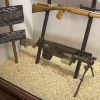Mosin Bubba
Member
- Joined
- Jul 5, 2012
- Messages
- 1,936
I got reading about some of those 1950s Project Salvo guns, where they tried building those fletchette rifles, and some of those results sound almost too good to be true. This is from Wikipedia:
"Various multiple barrel rifles entered the project. The resulting "burst simulators" were tested in 1961, and the general conclusion was that the light weight of the flechette meant that it could be fired at extremely high rates of fire, the baseline being 2300 rpm, from a weapon of only 3.5 pounds (1.6 kilograms), fully loaded with 60 rounds. Accordingly, the Army became extremely interested in the weapon.[citation needed]"
"Further development continued by adapting a Winchester Model 70 rifle with new XM110 5.6×53 mm rounds firing a single dart. The result was a weapon with somewhat less accuracy than the 7.62×51mm NATO rounds, but with equal penetration and a trajectory so flat it could be fired with no sight adjustment out to 400 yards (370 m). Better yet the rounds were very light, and had almost no recoil in comparison to even the 0.22-inch caliber weapons under development."
Now the article does mention that fletchettes were expensive and difficult to make accurate. The latter part sounds like it's kind of inherent to the darts, but I don't know if the former part could be fixed with economy of scale.
Still - a 3 pound rifle with zero recoil and no drop out to 400 yards? Why didn't these wunder-guns make it into production?
Obligatory pictures of said space age wunder-guns



"Various multiple barrel rifles entered the project. The resulting "burst simulators" were tested in 1961, and the general conclusion was that the light weight of the flechette meant that it could be fired at extremely high rates of fire, the baseline being 2300 rpm, from a weapon of only 3.5 pounds (1.6 kilograms), fully loaded with 60 rounds. Accordingly, the Army became extremely interested in the weapon.[citation needed]"
"Further development continued by adapting a Winchester Model 70 rifle with new XM110 5.6×53 mm rounds firing a single dart. The result was a weapon with somewhat less accuracy than the 7.62×51mm NATO rounds, but with equal penetration and a trajectory so flat it could be fired with no sight adjustment out to 400 yards (370 m). Better yet the rounds were very light, and had almost no recoil in comparison to even the 0.22-inch caliber weapons under development."
Now the article does mention that fletchettes were expensive and difficult to make accurate. The latter part sounds like it's kind of inherent to the darts, but I don't know if the former part could be fixed with economy of scale.
Still - a 3 pound rifle with zero recoil and no drop out to 400 yards? Why didn't these wunder-guns make it into production?
Obligatory pictures of said space age wunder-guns


